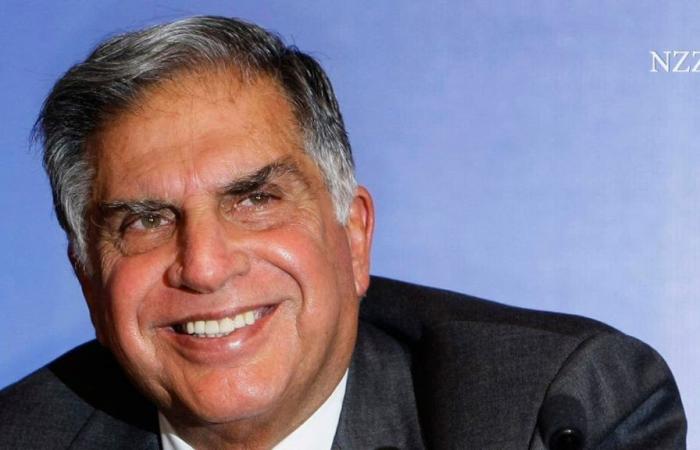The long-time head of the Tata empire was considered a shy, modest man who preferred to surround himself with dogs. His global expansion course was not without problems, but was ultimately successful.
Ratan Tata directed the fortunes of the Indian corporate empire for more than two decades.
Gautam Singh / AP
A visionary, a lighthouse, a legend: Hardly a word was big enough for the Indians when the death of Ratan Tata became known on Thursday.
Business leaders, journalists and politicians of all stripes paid high tribute to the long-time head of the Tata empire. The state of Maharashtra, in whose capital Mumbai the headquarters of the group of companies is located, declared a day of national mourning. Home Minister Amit Shah personally attended the funeral of “the legendary industrialist and true nationalist”. The company patriarch died on Wednesday evening in a Mumbai hospital at the age of 86.
Over a million employees
Ratan Tata took over the management of the company from his uncle J. R. D. Tata in 1991. In his more than twenty years at the helm of the Tata Group, he turned the family business, founded in 1868, into a global corporation. Today it is present in a hundred countries and employs over a million people with a turnover of 165 billion dollars.
Although his father Naval Tata held leading positions in the group, Ratan Tata’s rise to the top position was not predetermined. The young Ratan initially studied architecture at New York’s Cornell University, but then returned to India at the urging of his grandmother Navajbai. Nevertheless, he was not considered the designated heir within the family for a long time and initially had a difficult time asserting himself in the company.
His greatest love was dogs
Ratan Tata was considered a shy and reserved man who, despite a penchant for sports cars and airplanes, lived relatively modestly in his hometown of Mumbai. Unlike other major industrialists such as Mukesh Ambani and Gautam Adani, he avoided flaunting his wealth. He remained single until the end of his life and had no children. Confidants reported that his greatest love was dogs. This went so far that he opened the lobby of the company’s headquarters in Mumbai to street dogs.
Ratan Tata was also a great patron who continued the family’s philanthropic tradition. The family came from the small but influential Parsee religious community. This goes back to Zoroastrian exiles who fled to India from the Islamization of Persia between the 8th and 10th centuries. Although there are only a few tens of thousands of Parsis left, they play a major role in Mumbai’s cultural and economic life.
For decades, the management of the Tata company was firmly in the hands of the family and the Parsis. The company’s current CEO, Natarajan Chandrasekaran, is the first person who does not belong to the Tata family by birth or marriage.
Nevertheless, the Tatas continue to retain significant influence in the corporate empire. It is expected that a Tata will once again take over the chairmanship of Tata Trusts. The foundation owns 66 percent of the holding Tata Sons, which controls the conglomerate.
The purchase of the steel giant Corus turned out to be a fiasco
But even if the Tata family has retained its influence, the group has diversified and internationalized under Ratan Tata. This began in 2000 with the purchase of the British tea manufacturer Tetley Tea. Seven years later, the takeover of the Dutch steel producer Corus followed. Shortly afterwards, Tata bought the traditional British brands Jaguar and Land Rover – which many Indians saw as a belated revenge against the old colonial power.
However, the purchase of Corus shortly before the financial crisis turned out to be a costly fiasco. Jaguar Land Rover was also initially in the red. Things were also not going well on the Indian car market during this time. With the Nano, Tata launched an affordable small car that was intended for the masses. But first there was a heated argument about the planned location of the Nano factory in West Bengal, and when the car came onto the market, hardly anyone wanted to buy it.
Ratan Tata’s image was further tarnished when he had a bitter feud with his successor Cyrus Mistry in 2016. At Tata’s instigation, Mistry was removed, after which Tata briefly took over management again. Mistry then accused him of violating the rules, nepotism and a lack of transparency. The public feud caused a great stir in India and damaged the patriarch’s reputation.
Recently, however, the entrepreneur has regained respect in India. This has contributed to the fact that the company is doing quite well again. Jaguar Land Rover is making big profits, and the Indian automobile division has also recovered after the debacle with the Nano. Today it is the market leader in electric mobility in India.
To Ratan Tata’s delight, in 2021 the group also bought back the national airline Air India, which was founded by Tata but nationalized in 1953. Despite the internationalization, Tata remains closely linked to India.






